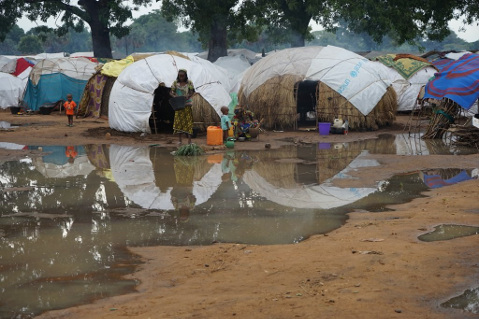The Food Crisis in South Chad
People Flee War and Genocidal Violence in Central African Republic

A food crisis faces the refugees in United Nations refugee camps in south Chad, which are populated by about 78,000 people fleeing genocidal violence in the Central African Republic. When I recently returned from the Chad Relief Foundation’s (CRF) 10th mission there, the camp populations had grown by 98,000 returnees — Chadian citizens who have been living in the Central African Republic and are settled in makeshift camps along the border.
Although the estimates of the food rations that the refugees receive do not all jibe, it is clear that there are serious shortages with serious consequences and no miracle that will set things straight in sight. Moreover, the nearly 100,000 returnees are generally in worse shape than the refugees and are dependent on many of the same resources. And the large numbers of new refugees place additional strain on the limited supply of land, tools, and seeds. Hunger eats away at all activities, including work and school.
We were told several versions of the current food ration, the consensus being that the refugees are receiving somewhere between 21 percent and 40 percent of the international standard set by the UN (2,100 calories per person per day). The deprivations were said to be worse for the nomadic refugees and for girls. Whatever the version, unless substantial improvement takes place by September 2014, our contacts agree widespread malnutrition and death are likely to occur.
In several returnee camps, vouchers rather than food are distributed. The vouchers, equivalent to 4000 CFA (or $8) per person per month, can be traded for food at local markets at prices fixed by the government. Merchants can cash the vouchers with the government. Everyone agrees that the amount of food that can be purchased with 4000 CFA/month is totally inadequate.
Just as I returned to Santa Barbara, the UNHCR (UN High Commissioner for Refugees) informed me that while I was in the field in Chad, the World Food Program promised to increase the ration for new refugees to the “full food basket.” Though this change in policy, if it actually occurs, will very substantially improve food security for new refugees, it does not change the situation of the long-term refugees, and more important because their situation is more precarious, that of the returnees.

How do the refugees cope with not having enough to eat? They forage for wild roots, gather wood (illegally) in the forest to sell, hang around the market looking for scraps, try to find the odd job, trade sex (illegally) for food or money, steal, sell other stuff. Those who know how to farm, can farm when the rains come. If they have seeds, tools, and land.
I heard a couple of food reallocation plans while I was in Chad, and though they may have been overtaken by events by now, they illustrate the complexity of the problems. One idea is to eliminate the ration for old refugees and restore it for new refugees — which only affects sorghum, not the oil and salt refugees receive — because established refugees ought to be able to cope without food aid. Older refugees had varying responses to this idea: In Gondje camp, they were confident that if they had seeds, fertilizer, and pesticides, they could manage. But in Amboko camp, where refugees had cultivated the same fields for more than 10 years, they were alarmed because the fields were overworked and had become unproductive.
The other plan is based on a 2012 household economic analysis that divided the refugee population into four groups. 1) Vulnerable refugees would get total assistance, 2) less vulnerable folks would initially get total assistance but face reductions, 3) better-off refugees get little assistance on a case-by-case basis, and 4) the well-off would get nothing. Such a regime is said to have worked in Mali. The problem is that the system is based on 2012 determinations of size for the four groups. New refugees change the proportions (and in the direction of the more vulnerable), and the aggregate need will get greater, but the supply may not.
Everyone I asked said that the Chad Relief Foundation’s highest priority should be food assistance. We are too late to help with the grands champs (“great fields”) program that is just about to get underway. But we will provide assistance to the winter gardening (vegetables) program that begins in October. The more support Chad Relief Foundation gets from the Santa Barbara community, the more we will be able to help these hungry people.
William Felstiner is president of Chad Relief Foundation, a nonprofit based in Santa Barbara, California.



